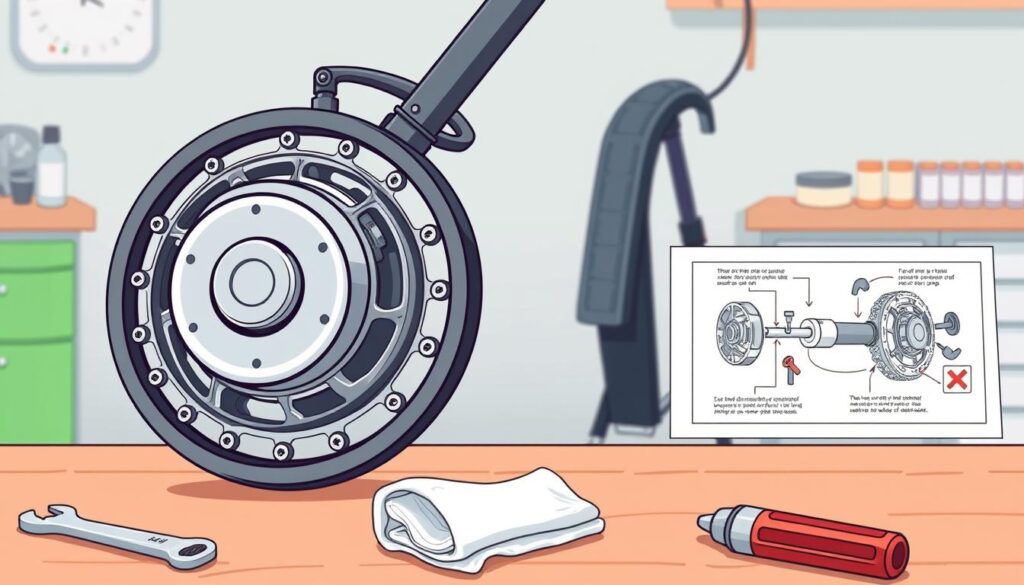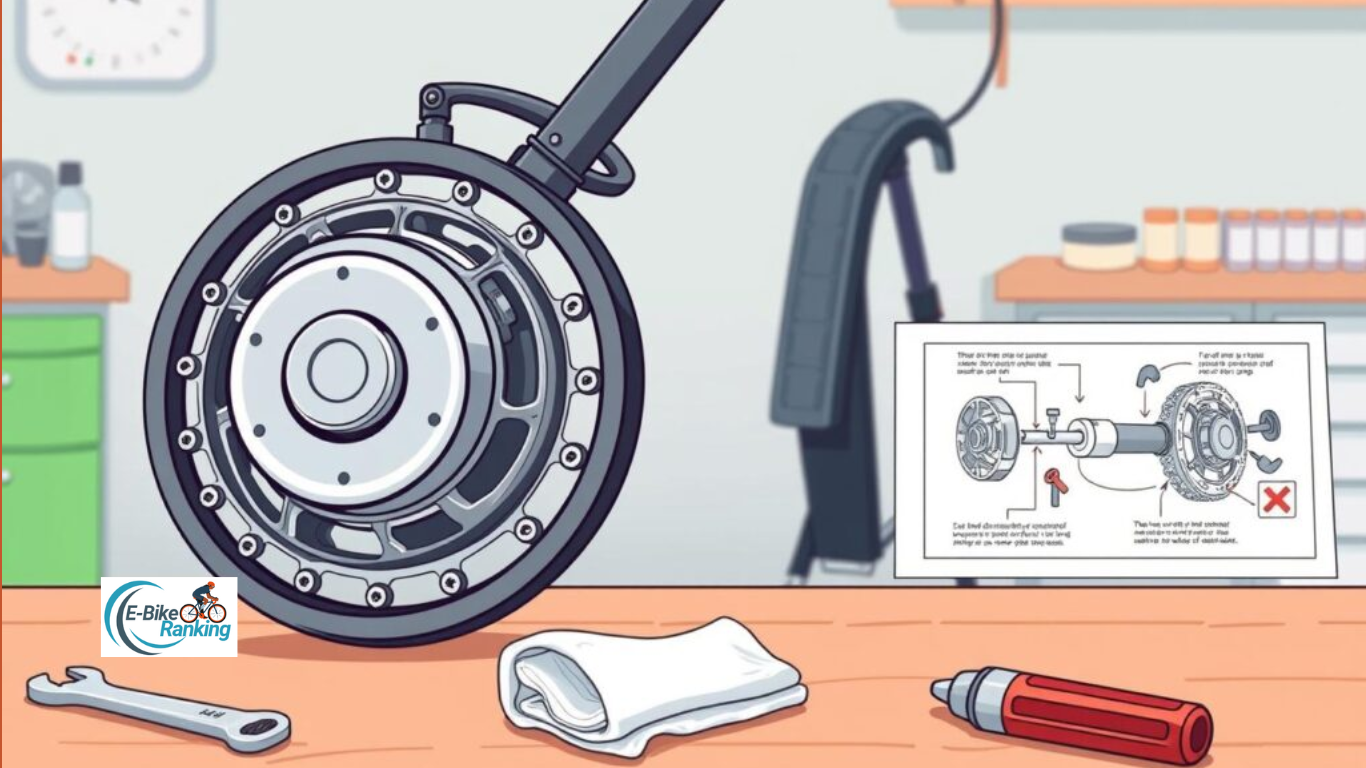Your ebike motor is the heart of your electric bike. Taking good care of it ensures it works well for years. This guide from ebikeranking shows how to keep your motor in top shape. Simple steps can prevent big problems and keep your bike running smoothly.
Ebike motors need regular care to stay in good condition. This article offers tips for maintenance and troubleshooting. Whether you’re new to e-bikes or have been riding for a while, these steps can help your motor last longer. Learn how to spot and fix issues before they get worse.

Key Takeaways
- Check your ebike motor weekly to catch small issues early.
- Clean the motor area monthly to remove dirt and debris.
- Monitor battery health to maintain motor performance.
- Listen for unusual sounds like grinding or buzzing.
- Follow manufacturer instructions for best results.
Understanding Your E-Bike Motor System
Before you start on maintenance, it’s key to know the basics of your ebike motor. This knowledge helps you tackle problems more effectively. Let’s look at how various motor types and parts work together to ensure a smooth ride.
Different Types of E-Bike Motors Explained
- Hub Motors: These are mounted in the wheels, either at the front or rear. Brands like Bosch Performance Line and Shimano Steps use this design for its simplicity.
- Mid-Drive Motors: These are attached to the frame near the pedals. Yamaha’s PW series is a good example, offering better weight distribution.
- Friction Drive: Though rare, some cargo ebikes use this type. It relies on wheel contact points for power.
Key Components That Affect Motor Performance
| Component | Role |
|---|---|
| Controller | Manages power flow between battery and ebike motor. |
| Sensors | Monitor speed and pedal input for smooth assistance. |
| Wiring | Connects all parts; loose connections reduce efficiency. |
Signs Your E-Bike Motor Needs Attention
Listen for grinding noises from worn gears or vibrations signaling misalignment. Error codes on your display or sudden power loss during rides are red flags. Slower acceleration than usual also hints at underlying issues.
Essential Maintenance Routines to Extend Motor Life
Keeping your ebike motor in good shape is key to its longevity. Simple actions like weekly checks and seasonal tweaks can dodge expensive fixes. Follow these steps to ensure your motor stays in prime condition, as advised by ebikeranking pros.
Weekly Maintenance Checklist for E-Bike Motors
Spending just five minutes a week can make a big difference:
- Inspect chains and gears for wear
- Check tire pressure and brake alignment
- Ensure all bolts and connections are tightened
- Wipe down the motor housing with a dry cloth
Seasonal Care Tips for Different Weather Conditions
Adjust your care routine with the seasons:
| Season | Maintenance Tips |
|---|---|
| Winter | Remove ice gently; store in a dry place |
| Summer | Clean salt or sand buildup daily |
| Rainy Seasons | Use waterproof covers during storage |
Proper Cleaning Techniques That Won’t Damage Components
Cleaning with care is crucial to avoid damage:
- Use a soft brush to remove debris
- Apply a mild soap solution to non-electronic parts
- Never spray water directly on the motor
Battery Maintenance and Its Impact on Motor Performance
Proper battery care is essential:
- Charge when 20% power remains
- Avoid extreme temperatures during storage
- Calibrate charge cycles monthly
Regular battery checks improve motor efficiency and extend your ebike’s life.
How to Troubleshoot E-Bike Motor for Longevity and Performance
Spotting issues early keeps your ebike motor running smoothly. Start with basic checks before diving into complex repairs. Follow these steps to diagnose problems and avoid costly mistakes:
- Check battery connections and power levels first. A loose cable can mimic a motor fault.
- Listen for unusual sounds. Grinding noises often signal worn gears, while buzzing points to electrical issues.
- Test pedal-assist levels. If assistance drops suddenly, inspect the sensor or controller wiring.
| Symptom | Possible Cause | Action |
|---|---|---|
| No power output | Dead battery or fried circuit board | Charge battery fully; check fuses with a multimeter |
| Erratic assistance | Loose wheel sensor or corroded connectors | Realign sensors; clean terminals with alcohol wipes |
Always carry a multimeter and hex keys for basic diagnostics. If symptoms persist after these checks, it’s likely a mechanical issue like a seized rotor or belt misalignment. For persistent electrical faults, visit an authorized service center. Early action prevents small issues from becoming major repairs.
Common E-Bike Motor Problems and DIY Solutions
Having trouble with your e-bike motor doesn’t always mean you need to spend a lot. Many common issues can be fixed with simple tools and some guidance. For detailed steps, check out ebikeranking for troubleshooting guides for your model.
Diagnosing Unusual Noises and Vibrations
Grinding or whirring sounds often mean something is worn out. First, check:
- Loose bolts or mounting hardware
- Worn bearings in wheels or cranks
- Chain misalignment or slack
Re-tighten bolts and lubricate parts carefully. But, if noises keep coming back, you might need to replace bearings. This is a job for the pros.
Fixing Power Delivery Issues and Unexpected Shutdowns
Having trouble with power or weak assistance? Here’s what to do:
- Battery check: Make sure it’s fully charged and check terminals for corrosion.
- Cable inspection: Look for frayed wires or loose connectors.
- Controller test: Try restarting the system or update firmware if you can.
If the problem keeps happening, reach out to the manufacturer for help or repair options.
When to Replace Parts vs. When to Upgrade
Wondering if you should replace parts or upgrade? Think about:
- Cost of parts vs long-term savings
- Compatibility with your ebike model
- Performance gains vs repair costs
“Always prioritize safety. If unsure, consult a professional or use ebikeranking’s compatibility checker for part recommendations.”
Upgrading, like getting a new battery or controller, can improve performance. But make sure it fits your e-bike’s design.
Conclusion: Maximizing Your E-Bike Motor’s Lifespan
Regular care and quick fixes are crucial for your ebike motor’s longevity. Weekly checks, seasonal tweaks, and cleaning keep issues like strange noises or power drops at bay. Bosch and Yamaha motors, for example, thrive with regular lubrication and battery care, as their manuals suggest.
Make a maintenance plan that fits your riding habits and local weather. If you ride in rainy areas, focus on keeping electronics dry. In hilly places, check brake and motor alignment more frequently. Keeping a logbook of service dates helps catch problems early, saving you from expensive repairs later.
Having a good relationship with certified techs ensures complex problems get the right attention. Brands like Specialized and Rad Power Bikes suggest professional checks every 1,000 miles. Investing a little in maintenance now keeps your ebike motor running well and boosts its resale value.
Simple actions like checking tire pressure, tightening loose parts, and storing batteries at 50% charge can extend your motor’s life. These small steps today mean better rides tomorrow. Your ebike motor will stay reliable, whether you’re commuting in Chicago’s cold or exploring Colorado’s trails.
FAQ
How often should I perform maintenance on my e-bike motor?
Check your e-bike every 100 miles for a detailed maintenance check. But, a quick weekly check can spot problems early. Don’t forget to clean and care for your battery for the best performance.
What are the signs that my e-bike motor needs attention?
Look out for odd noises, vibrations, or if the power isn’t helping like it should. Also, watch for error codes on your e-bike’s screen. If you see these signs, find out what’s wrong before it gets worse.
What type of e-bike motor is best for different terrains?
Mid-drive motors are great for hills because they offer strong torque. Hub motors work well on flat ground. Choose based on where you ride most often.
Can I clean my e-bike motor myself?
Yes, but clean it safely to avoid harming the electronics. Don’t use high-pressure water. Instead, use a damp cloth and a soft brush around the motor.
What maintenance does my e-bike battery require?
Charge your battery as the maker suggests. Keep it in a cool, dry spot. Avoid letting it run out too often. Taking good care of it will make it last longer and work better.
Is it easy to troubleshoot problems with my e-bike motor?
Simple issues can be solved with basic checks and tools. But, for tricky problems, it’s wise to get a pro’s help to avoid mistakes.
When should I consider replacing my e-bike motor?
If many parts are breaking down or repairs cost too much, it might be time for a new motor. Also, if your motor is old and can’t keep up with your rides, upgrading could be a good idea.








